Solar eclipse of May 18, 1901
| Solar eclipse of May 18, 1901 | |
|---|---|
| Type of eclipse | |
| Nature | Total |
| Gamma | −0.3626 |
| Magnitude | 1.068 |
| Maximum eclipse | |
| Duration | 389 s (6 min 29 s) |
| Coordinates | 1°42′S 98°24′E / 1.7°S 98.4°E |
| Max. width of band | 238 km (148 mi) |
| Times (UTC) | |
| Greatest eclipse | 5:33:48 |
| References | |
| Saros | 136 (31 of 71) |
| Catalog # (SE5000) | 9283 |
A total solar eclipse occurred at the Moon's descending node of orbit on Saturday, May 18, 1901,[1][2][3][4][5] with a magnitude of 1.068. A solar eclipse occurs when the Moon passes between Earth and the Sun, thereby totally or partly obscuring the image of the Sun for a viewer on Earth. A total solar eclipse occurs when the Moon's apparent diameter is larger than the Sun's, blocking all direct sunlight, turning day into darkness. Totality occurs in a narrow path across Earth's surface, with the partial solar eclipse visible over a surrounding region thousands of kilometres wide. Occurring about 23 hours after perigee (on May 17, 1901, at 6:50 UTC), the Moon's apparent diameter was larger.[6]
The path of totality crossed French Madagascar (the part now belonging to Madagascar), Réunion, British Mauritius (now Mauritius), Dutch East Indies (now Indonesia), and British New Guinea (now belonging to Papua New Guinea). A partial eclipse was visible for parts of East Africa, South Asia, Southeast Asia, Australia, and Western Oceania.
Observations
[edit]The Joint Permanent Eclipse Committee of the Royal Society and Royal Astronomical Society observed the total eclipse in Padang on the west coast of Sumatra, Dutch East Indies. The weather was good after sunrise on May 18, but clouds gradually increased after the start of the eclipse. During the total phase, clouds continued to cover the sun and tended to become thicker, making it increasingly difficult to see the sun through the clouds.[7] A team from Lick Observatory, California also observed it in Padang.[8]
Eclipse details
[edit]Shown below are two tables displaying details about this particular solar eclipse. The first table outlines times at which the moon's penumbra or umbra attains the specific parameter, and the second table describes various other parameters pertaining to this eclipse.[9]
| Event | Time (UTC) |
|---|---|
| First Penumbral External Contact | 1901 May 18 at 02:59:47.9 UTC |
| First Umbral External Contact | 1901 May 18 at 03:56:01.2 UTC |
| First Central Line | 1901 May 18 at 03:57:29.2 UTC |
| First Umbral Internal Contact | 1901 May 18 at 03:58:57.4 UTC |
| First Penumbral Internal Contact | 1901 May 18 at 05:03:42.9 UTC |
| Equatorial Conjunction | 1901 May 18 at 05:28:40.2 UTC |
| Greatest Eclipse | 1901 May 18 at 05:33:48.0 UTC |
| Greatest Duration | 1901 May 18 at 05:35:43.3 UTC |
| Ecliptic Conjunction | 1901 May 18 at 05:37:30.7 UTC |
| Last Penumbral Internal Contact | 1901 May 18 at 06:04:00.5 UTC |
| Last Umbral Internal Contact | 1901 May 18 at 07:08:43.7 UTC |
| Last Central Line | 1901 May 18 at 07:10:10.7 UTC |
| Last Umbral External Contact | 1901 May 18 at 07:11:37.6 UTC |
| Last Penumbral External Contact | 1901 May 18 at 08:07:52.8 UTC |
| Parameter | Value |
|---|---|
| Eclipse Magnitude | 1.06800 |
| Eclipse Obscuration | 1.14063 |
| Gamma | −0.36258 |
| Sun Right Ascension | 03h37m03.3s |
| Sun Declination | +19°23'51.8" |
| Sun Semi-Diameter | 15'48.4" |
| Sun Equatorial Horizontal Parallax | 08.7" |
| Moon Right Ascension | 03h37m15.9s |
| Moon Declination | +19°02'00.5" |
| Moon Semi-Diameter | 16'37.0" |
| Moon Equatorial Horizontal Parallax | 1°00'58.9" |
| ΔT | -1.0 s |
Eclipse season
[edit]This eclipse is part of an eclipse season, a period, roughly every six months, when eclipses occur. Only two (or occasionally three) eclipse seasons occur each year, and each season lasts about 35 days and repeats just short of six months (173 days) later; thus two full eclipse seasons always occur each year. Either two or three eclipses happen each eclipse season. In the sequence below, each eclipse is separated by a fortnight.
| May 3 Ascending node (full moon) |
May 18 Descending node (new moon) |
|---|---|
 |

|
| Penumbral lunar eclipse Lunar Saros 110 |
Total solar eclipse Solar Saros 136 |
Related eclipses
[edit]Eclipses in 1901
[edit]- A penumbral lunar eclipse on May 3.
- A total solar eclipse on May 18.
- A partial lunar eclipse on October 27.
- An annular solar eclipse on November 11.
Metonic
[edit]- Preceded by: Solar eclipse of July 29, 1897
- Followed by: Solar eclipse of March 6, 1905
Tzolkinex
[edit]- Preceded by: Solar eclipse of April 6, 1894
- Followed by: Solar eclipse of June 28, 1908
Half-Saros
[edit]- Preceded by: Lunar eclipse of May 11, 1892
- Followed by: Lunar eclipse of May 24, 1910
Tritos
[edit]- Preceded by: Solar eclipse of June 17, 1890
- Followed by: Solar eclipse of April 17, 1912
Solar Saros 136
[edit]- Preceded by: Solar eclipse of May 6, 1883
- Followed by: Solar eclipse of May 29, 1919
Inex
[edit]- Preceded by: Solar eclipse of June 6, 1872
- Followed by: Solar eclipse of April 28, 1930
Triad
[edit]- Preceded by: Solar eclipse of July 17, 1814
- Followed by: Solar eclipse of March 18, 1988
Solar eclipses of 1898–1902
[edit]This eclipse is a member of a semester series. An eclipse in a semester series of solar eclipses repeats approximately every 177 days and 4 hours (a semester) at alternating nodes of the Moon's orbit.[10]
The solar eclipses on January 22, 1898 (total) and July 18, 1898 (annular) occur in the previous lunar year eclipse set, and the partial solar eclipse on April 8, 1902 occurs in the next lunar year eclipse set.
| Solar eclipse series sets from 1898 to 1902 | ||||||
|---|---|---|---|---|---|---|
| Ascending node | Descending node | |||||
| Saros | Map | Gamma | Saros | Map | Gamma | |
| 111 | December 13, 1898 Partial |
−1.5252 | 116 | June 8, 1899 Partial |
1.2089 | |
| 121 | December 3, 1899 Annular |
−0.9061 | 126 Totality in Wadesboro, North Carolina |
May 28, 1900 Total |
0.3943 | |
| 131 | November 22, 1900 Annular |
−0.2245 | 136 | May 18, 1901 Total |
−0.3626 | |
| 141 | November 11, 1901 Annular |
0.4758 | 146 | May 7, 1902 Partial |
−1.0831 | |
| 151 | October 31, 1902 Partial |
1.1556 | ||||
Saros 136
[edit]This eclipse is a part of Saros series 136, repeating every 18 years, 11 days, and containing 71 events. The series started with a partial solar eclipse on June 14, 1360. It contains annular eclipses from September 8, 1504 through November 12, 1594; hybrid eclipses from November 22, 1612 through January 17, 1703; and total eclipses from January 27, 1721 through May 13, 2496. The series ends at member 71 as a partial eclipse on July 30, 2622. Its eclipses are tabulated in three columns; every third eclipse in the same column is one exeligmos apart, so they all cast shadows over approximately the same parts of the Earth.
The longest duration of annularity was produced by member 9 at 32 seconds on September 8, 1504, and the longest duration of totality was produced by member 34 at 7 minutes, 7.74 seconds on June 20, 1955. All eclipses in this series occur at the Moon’s descending node of orbit.[11]
| Series members 26–47 occur between 1801 and 2200: | ||
|---|---|---|
| 26 | 27 | 28 |
 March 24, 1811 |
 April 3, 1829 |
 April 15, 1847 |
| 29 | 30 | 31 |
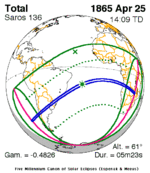 April 25, 1865 |
 May 6, 1883 |
 May 18, 1901 |
| 32 | 33 | 34 |
 May 29, 1919 |
 June 8, 1937 |
 June 20, 1955 |
| 35 | 36 | 37 |
 June 30, 1973 |
 July 11, 1991 |
 July 22, 2009 |
| 38 | 39 | 40 |
 August 2, 2027 |
 August 12, 2045 |
 August 24, 2063 |
| 41 | 42 | 43 |
 September 3, 2081 |
 September 14, 2099 |
 September 26, 2117 |
| 44 | 45 | 46 |
 October 7, 2135 |
 October 17, 2153 |
 October 29, 2171 |
| 47 | ||
 November 8, 2189 | ||
Metonic series
[edit]The metonic series repeats eclipses every 19 years (6939.69 days), lasting about 5 cycles. Eclipses occur in nearly the same calendar date. In addition, the octon subseries repeats 1/5 of that or every 3.8 years (1387.94 days). All eclipses in this table occur at the Moon's descending node.
| 22 eclipse events between March 5, 1848 and July 30, 1935 | ||||
|---|---|---|---|---|
| March 5–6 | December 22–24 | October 9–11 | July 29–30 | May 17–18 |
| 108 | 110 | 112 | 114 | 116 |
 March 5, 1848 |
 July 29, 1859 |
 May 17, 1863 | ||
| 118 | 120 | 122 | 124 | 126 |
 March 6, 1867 |
 December 22, 1870 |
 October 10, 1874 |
 July 29, 1878 |
 May 17, 1882 |
| 128 | 130 | 132 | 134 | 136 |
 March 5, 1886 |
 December 22, 1889 |
 October 9, 1893 |
 July 29, 1897 |
 May 18, 1901 |
| 138 | 140 | 142 | 144 | 146 |
 March 6, 1905 |
 December 23, 1908 |
 October 10, 1912 |
 July 30, 1916 |
 May 18, 1920 |
| 148 | 150 | 152 | 154 | |
 March 5, 1924 |
 December 24, 1927 |
 October 11, 1931 |
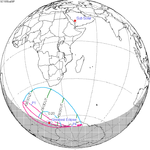 July 30, 1935 | |
Tritos series
[edit]This eclipse is a part of a tritos cycle, repeating at alternating nodes every 135 synodic months (≈ 3986.63 days, or 11 years minus 1 month). Their appearance and longitude are irregular due to a lack of synchronization with the anomalistic month (period of perigee), but groupings of 3 tritos cycles (≈ 33 years minus 3 months) come close (≈ 434.044 anomalistic months), so eclipses are similar in these groupings.
| Series members between 1801 and 2200 | ||||
|---|---|---|---|---|
 February 21, 1803 (Saros 127) |
 January 21, 1814 (Saros 128) |
 December 20, 1824 (Saros 129) |
 November 20, 1835 (Saros 130) |
 October 20, 1846 (Saros 131) |
 September 18, 1857 (Saros 132) |
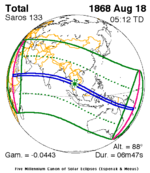 August 18, 1868 (Saros 133) |
 July 19, 1879 (Saros 134) |
 June 17, 1890 (Saros 135) |
 May 18, 1901 (Saros 136) |
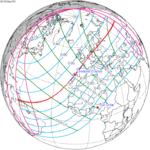 April 17, 1912 (Saros 137) |
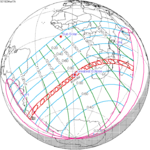 March 17, 1923 (Saros 138) |
 February 14, 1934 (Saros 139) |
 January 14, 1945 (Saros 140) |
 December 14, 1955 (Saros 141) |
 November 12, 1966 (Saros 142) |
 October 12, 1977 (Saros 143) |
 September 11, 1988 (Saros 144) |
 August 11, 1999 (Saros 145) |
 July 11, 2010 (Saros 146) |
 June 10, 2021 (Saros 147) |
 May 9, 2032 (Saros 148) |
 April 9, 2043 (Saros 149) |
 March 9, 2054 (Saros 150) |
 February 5, 2065 (Saros 151) |
 January 6, 2076 (Saros 152) |
 December 6, 2086 (Saros 153) |
 November 4, 2097 (Saros 154) |
 October 5, 2108 (Saros 155) |
 September 5, 2119 (Saros 156) |
 August 4, 2130 (Saros 157) |
 July 3, 2141 (Saros 158) |
 June 3, 2152 (Saros 159) |
 April 1, 2174 (Saros 161) | |
Inex series
[edit]This eclipse is a part of the long period inex cycle, repeating at alternating nodes, every 358 synodic months (≈ 10,571.95 days, or 29 years minus 20 days). Their appearance and longitude are irregular due to a lack of synchronization with the anomalistic month (period of perigee). However, groupings of 3 inex cycles (≈ 87 years minus 2 months) comes close (≈ 1,151.02 anomalistic months), so eclipses are similar in these groupings.
| Series members between 1801 and 2200 | ||
|---|---|---|
 July 17, 1814 (Saros 133) |
 June 27, 1843 (Saros 134) |
 June 6, 1872 (Saros 135) |
 May 18, 1901 (Saros 136) |
 April 28, 1930 (Saros 137) |
 April 8, 1959 (Saros 138) |
 March 18, 1988 (Saros 139) |
 February 26, 2017 (Saros 140) |
 February 5, 2046 (Saros 141) |
 January 16, 2075 (Saros 142) |
 December 29, 2103 (Saros 143) |
 December 7, 2132 (Saros 144) |
 November 17, 2161 (Saros 145) |
 October 29, 2190 (Saros 146) |
|
Notes
[edit]- ^ "May 18, 1901 Total Solar Eclipse". timeanddate. Retrieved 30 July 2024.
- ^ "Viewing the solar eclipse: Many of America's astronomers now on the other side of the globe". The Atchison Daily Globe. Atchison, Kansas. 1901-05-17. p. 7. Retrieved 2023-10-27 – via Newspapers.com.
- ^ "The sun eclipsed: On the whole astronomers have been disappointed". The Fresno Morning Republican. Fresno, California. 1901-05-19. p. 8. Retrieved 2023-10-27 – via Newspapers.com.
- ^ "The Eclipse of the Sun". Daily News Advertiser. Vancouver, British Columbia, Canada. 1901-05-19. p. 4. Retrieved 2023-10-27 – via Newspapers.com.
- ^ "What is the solar corona?". San Francisco Chronicle. San Francisco, California. 1901-11-10. p. 6. Retrieved 2023-10-27 – via Newspapers.com.
- ^ "Moon Distances for London, United Kingdom, England". timeanddate. Retrieved 30 July 2024.
- ^ H. F. Newall (1901–1902). "Total Solar Eclipse of 1901, May 17-18. Preliminary Report of the Observations Made at Ayer Karoe, Sawah Loento, Sumatra". Royal Society. pp. 209–234. Archived from the original on 9 October 2020.
- ^ C. D. Perrine (1 December 1901). "THE LICK OBSERVATORY-CROCKER EXPEDITION TO OBSERVE THE TOTAL SOLAR ECLIPSE OF 1901, MAY 17-18". Publications of the Astronomical Society of the Pacific: 187–204. ISSN 0004-6280.
- ^ "Total Solar Eclipse of 1901 May 18". EclipseWise.com. Retrieved 30 July 2024.
- ^ van Gent, R.H. "Solar- and Lunar-Eclipse Predictions from Antiquity to the Present". A Catalogue of Eclipse Cycles. Utrecht University. Retrieved 6 October 2018.
- ^ "NASA - Catalog of Solar Eclipses of Saros 136". eclipse.gsfc.nasa.gov.
References
[edit]- Earth visibility chart and eclipse statistics Eclipse Predictions by Fred Espenak, NASA/GSFC
- Photo of Solar Corona May 18, 1901
- Eclipse of May 18, 1901 (Sumatra). Contact print from the original glass plate negative. Lick Observatory Plate Archive, Mt. Hamilton.
- Total Eclipse of the Sun, May 18, 1901 Reports on the Dutch Expedition to Karang Sago, Sumatra, by Dr. A. A. Nijland, March 1903, Utrecht, Published by the Eclipse Committee of the Royal Academy, Amsterdam
- Russia expedition for solar eclipse of May 18, 1901




